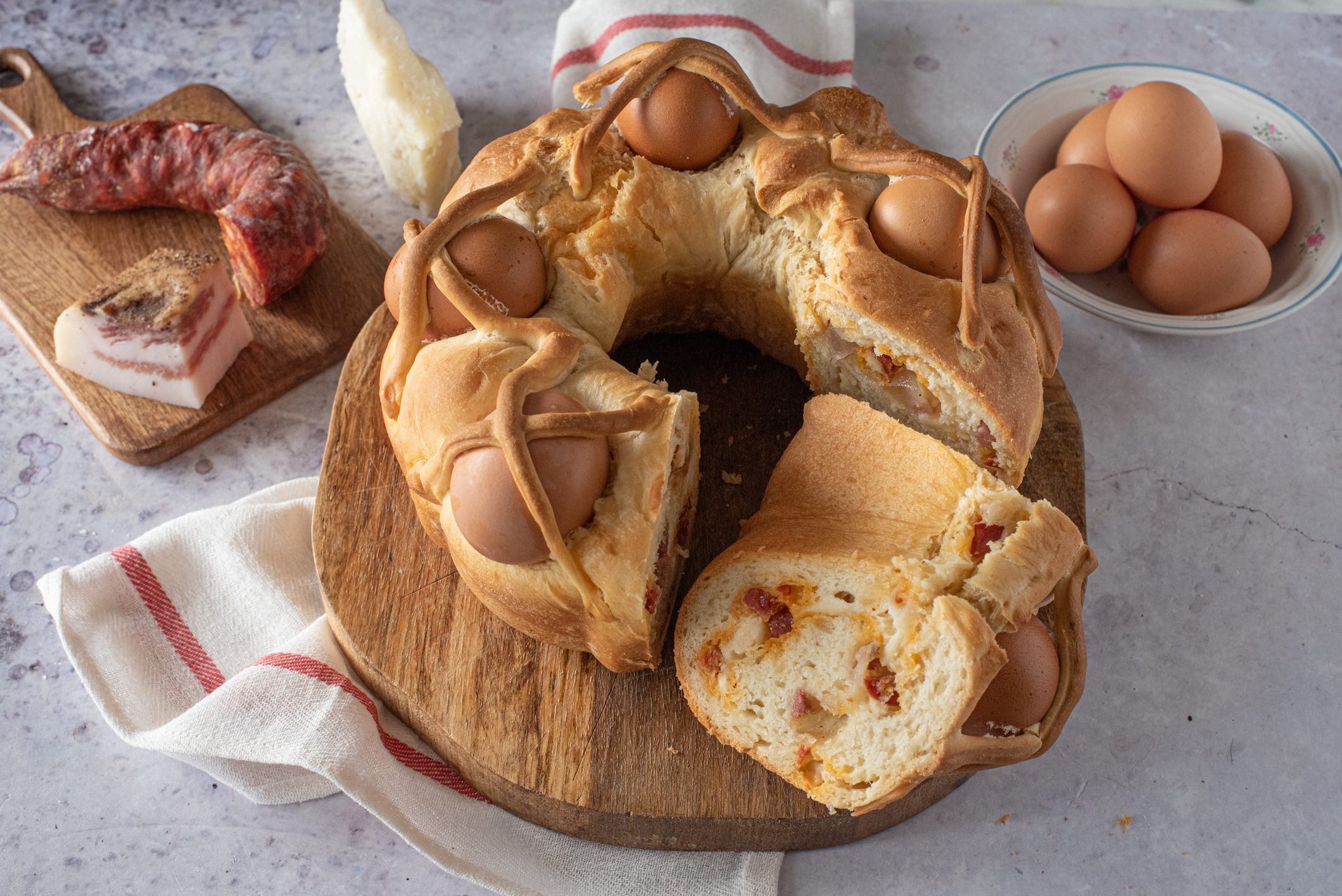Casatiello: the traditional recipe for the Neapolitan stuffed Easter bread
;Resize,width=742;)
The Casatiello is a traditional Italian recipe for making Neapolitan stuffed Easter bread. Savory and rich, it is a donut-shaped leavened bread whose dough is prepared with water, flour, lard, brewer’s yeast and salt. The stuffing consists of salami, cubed ham, spicy provolone cheese, lard and pepper. You must roll out the dough, add the ingredients, then roll up the dough on itself and place it in a round pan. Finally, you must add the eggs and tie them on the casatiello with strips of dough.
The casatiello is a fundamental food on the Campania Easter menu. Fresh decorative eggs are caged on top by a dough cross. This differentiates the casatiello from the tortano, another Neapolitan Easter bread where hard-boiled eggs are cut into small pieces and stirred in the dough.
You can store this savory bread for a very long time. Casatiello is traditionally made on Good Friday, but it is served until Easter Monday. It is usually eaten cold, but it can also be heated in the oven for a few minutes before serving. This dough can be used for other variants like the gluten-free one or the casatiello without lard.
Casatiello Origins
The name derives from Latin word caseus that means "cheese" in English and refers to the fact that it is a savory bread leavened with a large quantity of cheese. This is a very ancient recipe that originates in Greek-Roman Naples.
As with the pastiera (an Easter typical Neapolitan dessert) and for other traditional dishes, each family has its own recipe, especially regarding the stuffing.
Tips for making the Perfect Neapolitan Stuffed Easter Bread
If you want to use less brewer’s yeast, about 1-2 grams for every hectogram of flour, the processing times will be longer. In this case, use half all-purpose flour and half Manitoba flour. The latter contains a high quantity of gluten and proteins, and withstands long leavening in an optimal way. The casatiello, in fact, is a dough that requires many hours for a perfect leavening and, according to the traditional recipe, it should be made the day before, and let it rise overnight.
If the Neapolitan casatiello doesn't rise up, there is probably some mistake you made during preparation.
How to work and roll out the Casatiello Dough
You can work the dough kneading by hand or you can also use a stand mixer equipped with a hook.
To give the casatiello shape, you can flatten the dough also with the help of a rolling pin, in order to obtain an elongated shape to be rolled up, after adding the filling. If it breaks in some point, while you roll it up, take a piece of it from the end and seal the area that has opened, so that the stuffing does not come out during baking.
If you want to let the dough rise overnight, place it in the refrigerator and then let it come back to room temperature before kneading it.
The stuffing of the Casatiello
For the stuffing, you can also add other cold cuts, such as ham, bacon, and other cheeses such as scamorza cheese or provola cheese. The important thing, however, is not to use fresh or stretched curd cheeses such as mozzarella cheese. In case you don't find the cubed baked ham, you can replace them with bacon.
How to store Casatiello
You can store casatiello at room temperature for up to 4 days, well covered with cling film, in a cool place.
Alternatively, you can freeze it for 2 months, already baked with all the eggs. Let it cool completely before freezing it.
Ingredients
How to make the Neapolitan Casatiello
For the preparation you will need a round pan, that is the specific mold with the characteristic donut shape in which to bake the casatiello.
;Resize,width=712;)
For the preparation you will need a round pan, that is the specific mold with the characteristic donut shape in which to bake the casatiello.
Dissolve the brewer’s yeast in warm water.
;Resize,width=712;)
Dissolve the brewer’s yeast in warm water.
Collect the all purpose flour in the bowl of a stand mixer and pour the dissolved brewer’s yeast. Add the lard, salt and honey, and knead well until you get a soft and homogeneous mixture.
;Resize,width=712;)
Collect the all purpose flour in the bowl of a stand mixer and pour the dissolved brewer’s yeast. Add the lard, salt and honey, and knead well until you get a soft and homogeneous mixture.
Transfer the mixture to a work surface and knead for a few more minutes.
;Resize,width=712;)
Transfer the mixture to a work surface and knead for a few more minutes.
Form a ball and transfer it to a bowl, then cover it with a kitchen towel and let it rest for at least half an hour.
;Resize,width=712;)
Form a ball and transfer it to a bowl, then cover it with a kitchen towel and let it rest for at least half an hour.
Cut the salami and provolone cheese into cubes of approximately the same size.
How to string the casatiello
;Resize,width=712;)
Cut the salami and provolone cheese into cubes of approximately the same size.
Take back the dough and set aside a small piece, let’s say about 80 grams, which you will need for the final decoration. Roll out the remaining dough, using a rolling pin.
;Resize,width=712;)
Take back the dough and set aside a small piece, let’s say about 80 grams, which you will need for the final decoration. Roll out the remaining dough, using a rolling pin.
Sprinkle the surface with the cubed salami, provolone cheese and baked ham. Sprinkle with grated pecorino cheese and flavor with a generous grind of pepper.
;Resize,width=712;)
Sprinkle the surface with the cubed salami, provolone cheese and baked ham. Sprinkle with grated pecorino cheese and flavor with a generous grind of pepper.
Roll the dough on itself, until you get a nice loaf.
;Resize,width=712;)
Roll the dough on itself, until you get a nice loaf.
Arrange the dough in the round pan or in a 26 centimeters diameter donut mold, brushed with a little lard, and seal the two ends well.
;Resize,width=712;)
Arrange the dough in the round pan or in a 26 centimeters diameter donut mold, brushed with a little lard, and seal the two ends well.
With the dough kept aside, make 8 strips. Wash and dry the eggs, then arrange them in 5 well-spaced points, with light pressure. Close the eggs with the strips of dough, forming crosses, so as to seal them. Cover the casatiello with a clean cloth and let it rise away from drafts for about 2 hours, or in any case until the initial volume is doubled.
;Resize,width=712;)
With the dough kept aside, make 8 strips. Wash and dry the eggs, then arrange them in 5 well-spaced points, with light pressure. Close the eggs with the strips of dough, forming crosses, so as to seal them. Cover the casatiello with a clean cloth and let it rise away from drafts for about 2 hours, or in any case until the initial volume is doubled.
Brush the surface of the casatiello with the beaten egg yolk and bake the casatiello in a static oven at 338°F/170°C for about 50 minutes, placing it on the lowest shelf of the oven. Once ready, take the casatiello out of the oven and let it cool slightly, then take it out of the round pan and serve it immediately.
;Resize,width=767;)


;Resize,width=712;)
